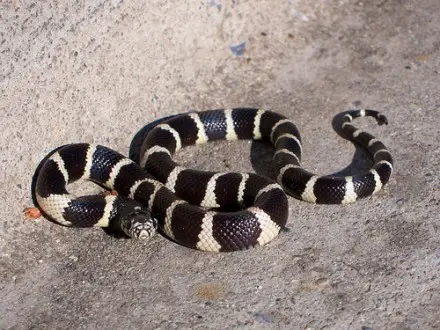The snake you are referring to is the California King snake which is located in the western and south-western areas of the United States. This species of snake is generally reared as a pet as they are harmless to humans and they can grow to 48 inches long with a girth of five inches. Even though the majority of them are black with white bands around them, some are black or dark brown with a single vertical line running from head to tail. Even though the name suggests they are common in California, they are also found in Oregon and Colorado. In addition, the California King snake can be found in the north of New Mexico and Arizona.
This species of snake usually lives in a desert-like habitat as well as coastal areas and pine forests. They tend to prefer open country spaces and refrain from living in thick forests and damp areas, however you may find them in open marshes. The California King snake tends to hide away during very hot days despite living in the desert, and instead comes out at night, however when the temperature is lower they become active during the day. When winter arrives these snakes go into brumation which is similar to hibernation due to the fact they gather in underground caves during the season. They eat small reptiles including frogs, lizards, small birds and rodents; however they are known to also eat other snake species. In addition, if they are surprised or get disturbed they can produce a similar rattle to a rattle snake.
This species of snake usually lives in a desert-like habitat as well as coastal areas and pine forests. They tend to prefer open country spaces and refrain from living in thick forests and damp areas, however you may find them in open marshes. The California King snake tends to hide away during very hot days despite living in the desert, and instead comes out at night, however when the temperature is lower they become active during the day. When winter arrives these snakes go into brumation which is similar to hibernation due to the fact they gather in underground caves during the season. They eat small reptiles including frogs, lizards, small birds and rodents; however they are known to also eat other snake species. In addition, if they are surprised or get disturbed they can produce a similar rattle to a rattle snake.

